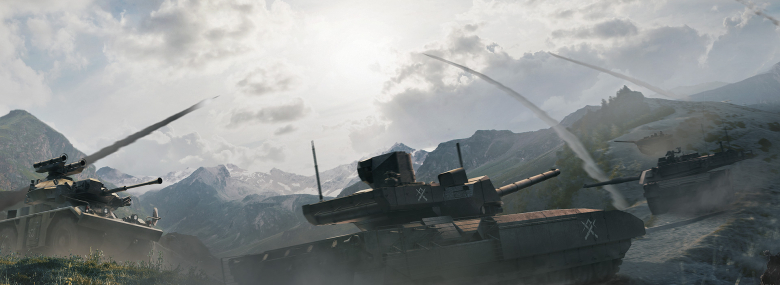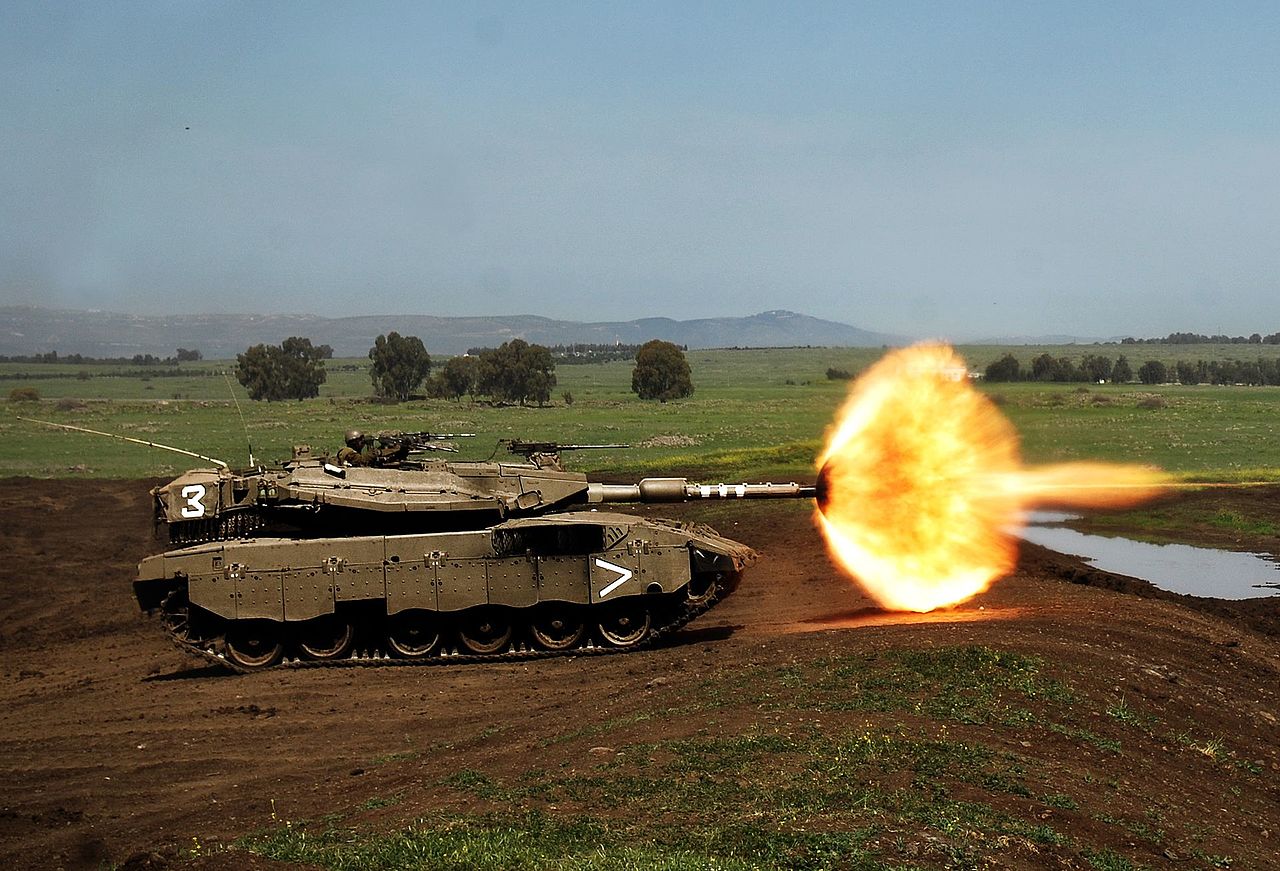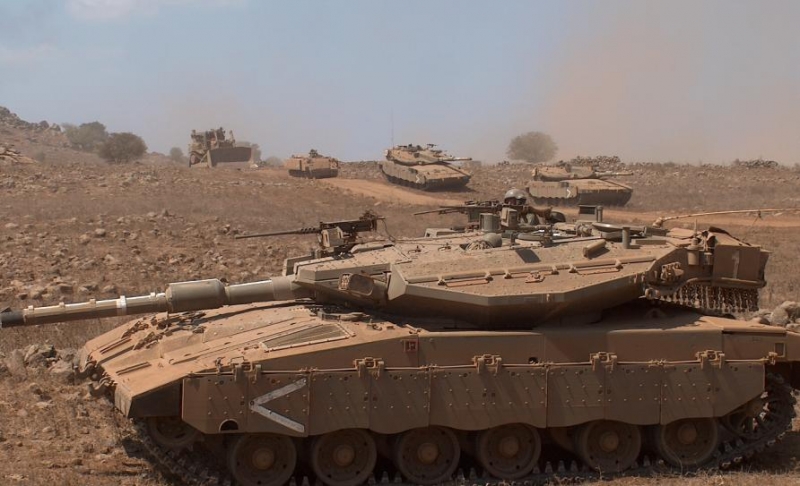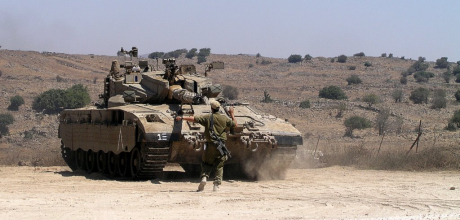
Commanders!
The Merkava series might have started with the proven and reliable 105mm rifled gun as its main armament but the Israeli engineers always of what the next step would be and designed it with a later installation of a larger gun in mind. That step was taken in the Merkava Mk.3 Main Battle Tank.
Where the Mk.2 model was basically just a partial upgrade to the Mk.1 or, if you will, “what Mk.1 should have been if the Israelis had more time and money”, the Mk.3 model was the first truly significant upgrade to the tank.

Merkava Mk.3D
The work on this new model started as early as in the August of 1983 – almost at the same time the Mk.2 model appeared in service. The Israelis were well-aware of the original design shortcomings and also knew that, even with the resources pouring into the project following the successful Merkava deployment in the 1982 Lebanese War, it would take a while to build a successor to the Mk.2 model.
Considering the scope of the upgrade, it didn’t actually last that long with the first prototype appearing around 1986. The “scope of the upgrade” part should be emphasized – despite its roughly similar looks, the Mk.3 was, compared to the Mk.2, essentially a completely new tank. Yes, it still had a frontal-mounted engine, four crewmembers and angled armor to provide as much protection as possible, but even its core components underwent a significant overhaul.
Let’s start with its armor because that part underwent some of the biggest changes. The Merkava Mk.1 and Mk.2 model armor was mostly steel. It was upgraded in the Mk.2 model based on the 1982 experience but it was still “just” steel. For the Mk.3 model, the frontal armor and the turret were heavily modified and consisted of modular composite armor (a laminate of steel and other unknown materials, likely ceramics). The modularity allows for much faster repairs.
The downside of the whole composite armor deal was that while it was not considerably heavier, the tank was larger than its predecessors. The turret was 22cm longer and the tank itself was over 40cm longer (the width and the height remained roughly the same).
The sides were still “just” steel but the frontal protection was significantly improved – especially against HEAT-based threats such as RPGs and guided missiles. This armor is sometimes referred to as “third generation” armor (first generation being steel only and the second one being the Blazer ERA).
This third generation armor also had multiple steel layers of various hardness designed to work in concert to provide as much protection as possible. Its protection level was said to be comparable to the Chobham technology used by the British and the Americans – it was quite advanced and reflected the rise of the Israeli military industry from the ranks of license producers to the one of a true military technology superpower. It’s worth noting that this new armor did not include an ERA kit (just like the old Merkava) – not because it couldn’t (an integral ERA was considered at some point) but allegedly because the father of the project, General Israel Tal, did not like it very much and preferred improved passive protection.
Like on the Merkava Mk.2, the side protection was enhanced by the introduction of heavy side skirts that acted as spaced armor. The bottom was (like on the other Merkava models) reinforced with an additional anti-mine plating, although this turned out to be not quite as effective as the Israelis had hoped – it worked well enough against standard mines but against massive IED’s deployed by terrorists (some containing over one hundred kilograms of explosives) it simply did not provide any protection.
Other Mk.3 protective measures included:
- Ancoram LWS-2 Laser Warning System (warning the crew when the tank is illuminated by an ATGM laser designator)
- IMI smoke grenade launchers
- NBC protection (combined with air conditioning as heat tends to significantly decrease the performance of any crew, no matter how used they are to it)
- Special individual ammo stowage fireproof containers (containing any ammunition fire long enough for the crew to get out in case a fire breaks out)
- Electric turret drive (eliminating the disadvantages of a hydraulic one)
And then there was the gun.

Merkava Mk.3
Instead of the old 105mm M68 variant, the Merkava Mk.3 was armed with the Israel Military Industries M251 120mm L/44 smoothbore gun. Now, you might be thinking, wait – 120mm L/44 smoothbore, that does sound familiar. Yes it does indeed – it’s quite possibly a variant of the Rheinmetall L/44 smoothbore with a modified breech and recoil system to allow for easy replacement of the M68, despite the Israeli claims otherwise.
The gun was built in Israel and, officially, it was also developed there (starting from 1983). How exactly did Israel get to develop and produce a 120mm L/44 smoothbore gun is a good question but given the decades-long and largely secret military cooperation between Israel and Germany and the fact that the Americans started mass-producing a similar gun from 1985 onwards for their M1A1 Abrams, the answer likely hides somewhere between the two.
Either way, the gun had practically the same characteristics as its European and American counterparts and could fire standard NATO 120mm smoothbore ammunition, offering Israel the access to virtually unlimited American ammunition stocks in case of an emergency. The thermal sleeve the gun was fitted in was, however, definitely purely of Israeli origin, as was the fire control system.
The Merkava Mk.3 was equipped with the Elbit Abir (also known as Knight) FCS, which was superior to the Mk.2’s Matador 2 in almost all aspects. I consisted of:
- Improved Neodymium YAG laser rangefinder
- Digital ballistics computer
- Cross-wind sensor
- Thermal imager
The fact that the gun was stabilized in two axes is not as impressive as the fact the FCS gun sights were as well, allowing the tank to fire very accurately on the move. The commander had panoramic sights at his disposal while the gunner controlled both the day sights as well as thermal optics. Additionally, the commander could access the gunner’s optical feed. The only downside of this sophisticated system was that the Knight was very, very expensive, increasing the price of each Mk.3 considerably compared to the Mk.2 (30 percent of the price of the entire tank fell to the FCS alone).
The gun was loaded manually but there was a five round semi-automatic “ready rack” mounted on the bottom of the turret as well as an improved loading mechanism (leveling the gun after each shot automatically) so even though the 120mm rounds were heavier, the general rate of fire remained roughly the same. What did change, however, was the gun depression – the turret design as well as its bulkier armor did not allow for the same values as on the previous models – the gun depression and elevation was thus reduced from -8.5/+20 degrees to -7/+20 degrees.
All these improvements also had another price – a weight increase. Surprisingly, thanks to the new technologies – especially used on the armor – it wasn’t all that much, mere 2 tons. The Merkava Mk.3 MBT weighed 65 tons. In order to cope with all that weight, another upgraded model of the AVDS-1790 diesel engine was introduced – the 1200hp AVDS-1790-2AR with Israeli-made Ashot transmission. With this powerful engine, the tank had a power-to-weight ratio of just below 19 hp/t and could go as fast as 55-60 km/h (different sources give different values). The suspension was further improved as wider tracks were installed.

Merkava Mk.3D
This way, the Merkava Mk.3 entered service after three years of additional testing and development, in the spring of 1989 with the first vehicles traditionally going to the Barak Brigade. By the time the production ended in 2003, perhaps 800 Mk.3s were built in total (sources vary between 650 to over a thousand). Throughout its production run, the Merkava Mk.3 was upgraded. For starters, the run consisted of four production batches. Batches 1 and 2 were roughly the same as the initial model but Batch 3 had improved passive roof armor (the same program as the late Mk.2B) in order to deal with situations where Hezbollah terrorists fired RPGs or ATGMs at vulnerable turret roofs. Some sources claim that this heavy armor also helped against top-attack missiles.
Starting from 1995 (six years into production), another new fire control system was introduced to the Batch 3 Merkava Mk.3 – the Barak Zoher (Bright Lightning), sometimes also shortened to BAZ (Hebrew for Falcon). The Mk.3 variant equipped with FCS is called Merkava Mk.3 Barak Zoher (or Merkava Mk.3 BAZ, or – in some sources – Merkava Mk.3B).
The Barak Zoher FCS was an upgraded Elbit Knight and is by itself also sometimes called Knight Mk.3. It was extremely sophisticated for its age and featured the hunter-killer capability – the commander had a fully stabilized panoramic sights set, allowing him to select targets independently on the gunner. The gunner then engaged the targets pre-selected by the commander. Other improvements of this FCS compared to the older Knight system included:
- Automatic target tracker and movement predictor
- Another version of an improved laser rangefinder
- Improved thermal imagers for both the commander and the gunner
- Interface improvements to make it significantly easier to operate
The last point was especially important, reducing the training time required to operate it and thus opening the Merkava gunner position again to conscripts who had trouble working with the older and complex Knight system. And not only that – the response time was improved so much that it was also possible to engage flying helicopters with the main gun using standard shells (including HEAT).
The ability to fire LAHAT gun-launched guided missiles was also included in the FCS. These were basically the 105mm gun missiles, adapted for the use in a 120mm gun, giving the Merkava Mk.3 a serious punch even at extreme distances. Finally, a new programmable round called Kalanit was developed for the Merkava – using its six sub-munitions, it could work as a standard HE, or in an air-burst mode, significantly improving the lethality against soft targets and replacing the HE and HEAT rounds in their respective roles.
And so we get to the final major upgrade of the Merkava Mk.3 – the Mk.3 Dor Dalet. Dor Dalet stands for “Fourth Generation” with the first three generations being steel, Blazer ERA and the Mk.3 composite armor.
Starting from the late 1990s, some service tanks (most or even all, depending on what source you choose to believe) as well as all newly produced (Batch 4) Mk.3 Barak Zoher tanks were upgraded with a new generation of composite plates, increasing their considerable protection levels even further. It’s worth noting that these plates looked mostly similar to those used on the Merkava Mk.2D but their composition was different.

Merkava Mk.3D
Much attention has been given to improving the protection of the most vulnerable areas such as the turret roof, vehicle sides and the turret ring. The vehicle also received heavier roadwheels – these were made from actual armor steel with the intention of acting as spaced armor. The engine was also upgraded for improved reliability and to cope with the extra weight (estimated at perhaps another five tons).
The Merkava Mk.3 remains the mainstay of the IDF tank forces as the most numerous Merkava model although it is slowly being replaced by the Merkava Mk.4. It was never really used in active tank versus tank combat but has seen a lot of service against Hezbollah insurgents. These actions that usually took place in urban environment spawned numerous ad-hoc individual improvements such as various meshes being welded over the tank’s sensitive areas, removed external stowage baskets (their contents tended to catch fire when hit by a molotov cocktail).
In Armored Warfare, the Merkava Mk.3D will be an Israeli Branch Tier 8 Progression Main Battle Tank.

Merkava Mk.3D
Gameplay-wise, it will continue with the same style as its Tier 6 predecessor as a mixture of the “front line fighter” Mk.1 approach and the “sniper” Magach approach. Its armor will not be the thickest of its Tier but it will have the most hitpoints of all Tier 8 MBTs. The basic model will be the Mk.3 Barak Zoher and will feature two protection upgrades:
- The Dor Dalet armor kit
- Active Protection System
Mobility-wise it will be, just like its real life counterpart, superior to the Mk.2 but where it will really shine will be its firepower. The Mk.3 will feature high damage per minute value, solid penetration, a Ready Rack and the ability to fire LAHAT guided missiles.
We hope that you will enjoy it and will see you on the battlefield!








